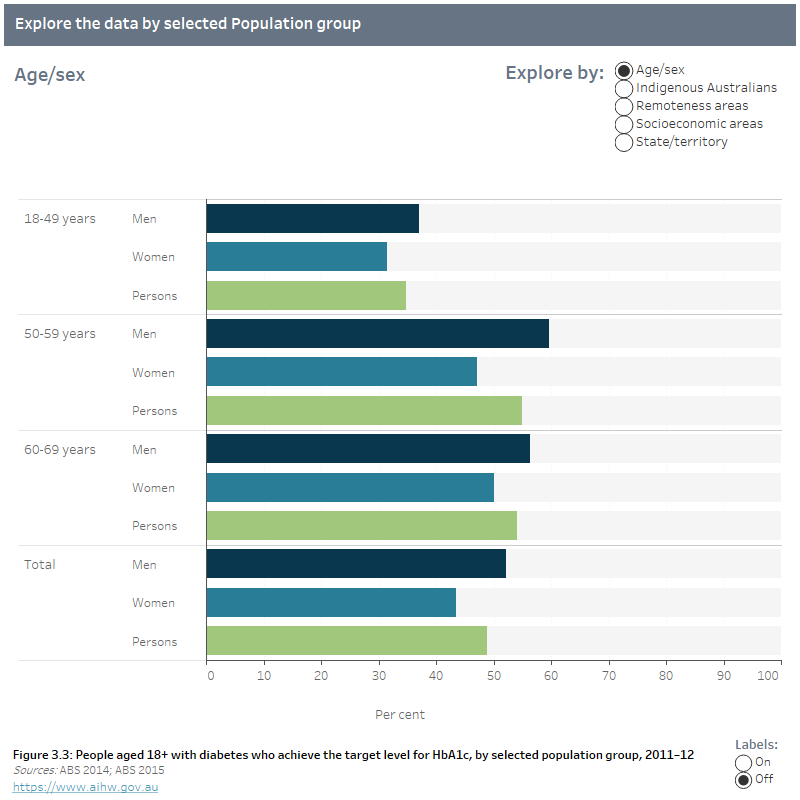Indicator 3.3 People with diabetes who achieve the target level for HbA1c/Effective management of diabetes
Considerations
- Data for this indicator are not available for update—baseline results reported.
- Baseline data has been restricted to people aged 18–69 years.
- Glycosylated haemoglobin (HbA1c) can be used to assess the average blood glucose over the preceding 6–8 weeks and is considered the best method for assessing glycaemic control (Phillips 2012). Targets for HbA1c in people with diabetes should be individualised, but a general target of less than or equal to 7.0% is recommended for people with type 2 diabetes (RACGP 2020).
- This indicator is for people aged 18–69 years and does not measure people aged 70 years and over who have achieved target HbA1c of less than or equal to 7.0%. The age group (18–69 years) was selected as targets for older people with diabetes are individualised and less strict (RACGP 2020).
- While the data for this indicator relate to people with all types of known diabetes (excluding gestational diabetes) the target HbA1c of ≤7.0% is not considered appropriate for people with type 1 diabetes. The type of diabetes cannot be determined from biomedical estimates from the Australian Health Survey and it is assumed that the vast majority of known diabetes would be type 2 diabetes.
- As the analysis has been restricted to specific age groups, age-standardised proportions were not derived.
Overview
In 2011–12, an estimated 49% of adults aged 18–69 with known diabetes achieved the target level for HbA1c (≤7.0%), based on measured data from the Australian Health Survey.
Age and sex
In 2011–12, 52% of men and 44% of women with known diabetes met the target level for HbA1c in 2011–12. Overall, 35% of adults aged 18–49 effectively managed their diabetes and this proportion rose to 55% among those aged 50–59 and 54% among those aged 60–69 (Figure 3.3).
Population groups
The proportion of people who effectively managed their diabetes did not vary by remoteness or socioeconomic areas (Figure 3.3).
State and territory
After adjusting for age, the proportion of people who effectively managed their diabetes varied across the states and territories (Figure 3.3).
Aboriginal and Torres Strait Islander people
In 2012–13, more than one third (36%) of Indigenous adults with known diabetes achieved the target level for HbA1c, based on data from the Aboriginal and Torres Strait Islander Health Survey (Figure 3.3).
About the data
People who had been told by a doctor or nurse that they have diabetes but who were not taking medications for diabetes and their HbA1c test results between 6.5% and 7.0% were also considered to have known diabetes and classified as effectively managing diabetes for this indicator.
Explore the data
3.3 People with diabetes who achieve the target level for HbA1c, by selected population group, 2011–12
The chart shows almost 50% of people with diabetes achieved the target level for HbA1c in 2011-12. Proportions were slightly higher among males than females for all age groups, with around 54% of persons aged 60-69 and 35% of persons aged 18-49 achieving the target. Around 33% of Indigenous males and 38% of Indigenous females achieved the target level for HbA1c. Proportions were higher in Major cities (51%) compared to Inner regional areas (43%) and was slightly lower in the lowest socioeconomic group (43%) compared to the highest group (47%). Among the states and territories, proportions were highest in Western Australia (60%) and lowest in the Northern Territory (23%).

|
|
Definition |
Data source |
|---|---|---|
|
Numerator |
Estimated number of adults aged 18–69 years with known diabetes with an HbA1c < 7%. Known diabetes includes people ever told by a doctor or nurse that they have diabetes (type 1, type 2 or type unknown) and they were taking diabetes medication (either insulin or tablets); or ever told that they have diabetes and their HbA1c test results were greater than or equal to the cut off point for diabetes (that is, 6.5%). |
ABS 2015; ABS 2014 |
|
Denominator |
Estimated number of adults (18–69 years) with known diabetes. Known diabetes includes people ever told by a doctor or nurse that they have diabetes (type 1, type 2 or type unknown) and they were taking diabetes medication (either insulin or tablets); or ever told that they have diabetes and their HbA1c test results were greater than or equal to the cut off point for diabetes (that is, 6.5%). |
ABS 2015; ABS 2014 |
Australian Bureau of Statistics (ABS) 2014. Microdata: Australian Health Survey, Core Content - Risk Factors and Selected Health Conditions, 2011–12. ABS cat. no. 4324.0.55.003. Findings based on Detailed Microdata analysis. Canberra: ABS.
ABS 2015. Microdata: Australian Aboriginal and Torres Strait Islander Health Survey, Core Content - Risk Factors and Selected Health Conditions, 2012–13. ABS cat. no. 4715.0.30.003. Findings based on Detailed Microdata analysis. Canberra: ABS.
Phillips PJ 2012. HbA1c and monitoring glycaemia. Australian family physician 41(1/2):37.
The Royal Australian College of General Practitioners (RACGP) 2020. Management of type 2 diabetes: A handbook for general practice. East Melbourne: RACGP. Viewed 4 August 2020.


